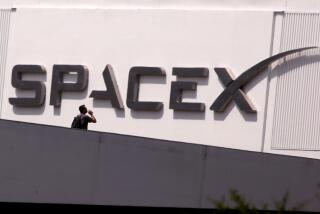Firm to Aid Hobbled Hubble : Company, Which Built Parts for Scope, to Offer New Ones
CHATSWORTH — Frustrated. That’s how Ernest Schaeffer feels about the Hubble Space Telescope, as do many Americans who are disappointed that the spacecraft has been plagued by problems almost from the instant it was launched 19 months ago.
Except that Schaeffer has more at stake.
His small firm, Schaeffer Magnetics Inc. in Chatsworth, made the 57 motors and actuators that control the mirrors, door latches, antennas and other equipment on the $2-billion spacecraft. The Hubble was the company’s biggest contract in dollar volume ($3 million) and number of units since Schaeffer started the firm 25 years ago.
“Just because we were part of it doesn’t change our feelings of frustration,” he said of the hobbled Hubble, “just as the whole general public feels it and asks the question: ‘Why?’ ”
And Schaeffer takes little comfort in knowing that none of his products are to blame for the problems of the Hubble, which is supposed to give astronomers an unprecedented view of the outer edges of the universe. “Everything we have done, and I’m knocking on wood, has worked fine,” Schaeffer said.
The 13-ton satellite’s maladies are a flawed primary mirror, which blurs its vision, and vibrating solar panels that threaten Hubble’s long-term power supply. Also, two of its six gyroscopes--which keep the Hubble steadily focused--are broken.
The National Aeronautics and Space Administration plans to fix Hubble with a mission scheduled for November, 1993. Space shuttle astronauts would reach Hubble’s 370-mile altitude above Earth, fetch the 42.5-foot telescope, secure it to the shuttle’s bay and fit it with new parts.
It’s an arduous task, but NASA had planned to put replacement parts on the Hubble even before the telescope’s flaws were discovered in space. Indeed, Schaeffer Magnetics was under contract to build new actuators and other replacement parts for Hubble before its launch--a contract worth about $700,000.
“The plan has always been to refurbish, upgrade and repair the Hubble on a regular basis, roughly every three years,” said Dennis McCarthy, deputy project manager for the Hubble-servicing team at NASA’s Goddard Space Flight Center in Greenbelt, Md.
NASA seldom goes into space without Schaeffer’s motors. They have helped operate components on the Apollo manned spacecraft and such U.S. exploratory satellites as Pioneer, Voyager, Mariner and Magellan.
“He is very thorough and very reliable,” said Cornelis deKramer, a systems manager at Goddard who has dealt with Schaeffer for 20 years. DeKramer said he could not recall a Schaeffer product ever failing in space.
Schaeffer Magnetics, which Schaeffer owns outright, has annual revenue of only $15 million and 135 employees, but it’s not in a high-volume business. The company’s products are unique, made to rigorous specifications because of their use in space, and virtually hand-built.
Schaeffer’s original Hubble motors were built nearly a decade ago. But the spacecraft’s launch, originally scheduled for 1983, was repeatedly delayed, first for technical problems and then because of the space shuttle Challenger’s explosion in 1986.
That lag between the time when Schaeffer completes his job and when his products are actually employed is not unusual, he said. “You kind of push it to the background,” he said. “You go on to other things. We feel we’ve done the best we can and we just wait for the outcome.”
Despite setbacks such as Hubble, Schaeffer said prospects for his business remain excellent because “we’re never going to stop flying in space.” Also, international space projects are a growing source of income, accounting for 20% of his revenue today versus zero in 1987. Schaeffer has contracts to supply motors and actuators for telecommunications satellites developed by France, Japan, Italy and Spain.
Schaeffer also just built some products for the U.S. science spacecraft Explorer Platform that’s scheduled for launch in January. He’s also supplying motors for the U.S.-French TOPEX satellite, expected to be launched next year, that will record data on the oceans and their effect on climate.
In the meantime, Schaeffer, at age 66, has more pressing down-to-earth problems that trouble many other entrepreneurs. Namely, he’s trying to figure out how to best surrender control of his company before retiring. How does he turn over ownership of such a niche operation to strangers, since his two daughters aren’t involved with the firm?
“I’ve been preoccupied with that question for the last 10 or 12 years,” he said. “If there’s a buyer, I’ll sell it, but I haven’t been able to find an appropriate buyer. You don’t just sell it to anybody.”
The succession question even dogged Schaeffer when he was getting an MBA from Pepperdine University in 1980. For his thesis, he discussed how entrepreneurships are sold. “I thought I could get some insight into it if I did a thesis on it,” he recalled.
Schaeffer reached one conclusion, though. The sale of an entrepreneurship, at least for the entrepreneur, “is an irrational process” because the owner is simply too attached to the business to rationally evaluate its potential sale. “If he really wants to sell his company, he should get other people involved to do the actual transaction,” Schaeffer said.
His love affair with space began when he was growing up in the Bronx borough of New York City, where he made airplanes from wood. During World War II, he helped design military planes, and after moving to Southern California in 1956, he began designing specialized motors for aircraft, space and science.
For a few years he worked at Whittaker Corp., then licensed all of his motor designs from Whittaker to start his own company in 1966. Eventually his firm was making actuators for satellites and switches that helped operate tape recorders on Apollo missions.
More to Read
Inside the business of entertainment
The Wide Shot brings you news, analysis and insights on everything from streaming wars to production — and what it all means for the future.
You may occasionally receive promotional content from the Los Angeles Times.











